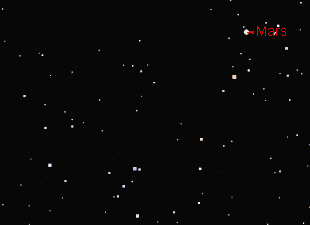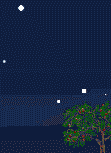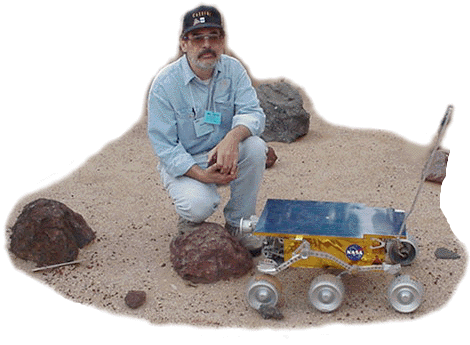





Thursday's Classroom

| Volume 7 Issue 05 | May 2001 | |
| What's Up? -- April 2001 | ||
|
This month marks the beginning of somewhat planet-less evenings for a while. Since this past winter the two giant planets, Jupiter and Saturn have been very visible. Now they are moving toward conjunction with the sun, which as we view it from Earth, means that they are moving along their orbits and soon will be on the opposite side of the sun. However within a few months both planets will be visible in the east as they re-appear from behind the sun, and will be rising ahead of the sun. While the absence
of the two giant planets may certainly be missed the 'red planet' Mars slowly
moves into the evening skies during this month. In fact it could almost be said
that Mars backs into the evening skies as about midway through the month the
regular eastward motion comes to a halt For an outer planet, such as Mars, retrograde motion occurs as the faster moving Earth catches up and then passes by. As we observe the outer planet with respect to the stars in the background it appears that the outer planet slows down and then reverses its eastward direction toward the west, and then after a time reverses its direction again, but this time toward its regular eastward direction of motion.
|
 and then Mars starts moving in the
opposite direction, backward toward the west. This apparent motion of Mars is
called
and then Mars starts moving in the
opposite direction, backward toward the west. This apparent motion of Mars is
called  During this month
the rapidly moving planet Mercury shakes things up a bit by
making its best appearance of the year during May. Observe the skies over
west-northwestern horizon shortly after sunset during the first two weeks of
the month and Saturn and Jupiter will be visible. Keep an eye on this area as
the rapidly moving Mercury passes by Saturn and then Jupiter. This animated image
starts on 6 May with Mercury north of Saturn. At one-day intervals Saturn quickly
disappears below the horizon while Mercury climbs higher above the horizon toward
conjunction with Jupiter on the 15th-16th.
During this month
the rapidly moving planet Mercury shakes things up a bit by
making its best appearance of the year during May. Observe the skies over
west-northwestern horizon shortly after sunset during the first two weeks of
the month and Saturn and Jupiter will be visible. Keep an eye on this area as
the rapidly moving Mercury passes by Saturn and then Jupiter. This animated image
starts on 6 May with Mercury north of Saturn. At one-day intervals Saturn quickly
disappears below the horizon while Mercury climbs higher above the horizon toward
conjunction with Jupiter on the 15th-16th.
 These Articles, activities, and the monthly newsletter may be reproduced for classroom use; inclusion in another newsletter,
or linked with another web site, without written permission. Any other use will require written permission.
These Articles, activities, and the monthly newsletter may be reproduced for classroom use; inclusion in another newsletter,
or linked with another web site, without written permission. Any other use will require written permission.